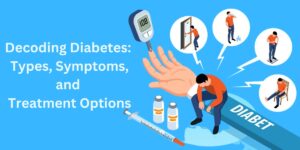- Attapur & Tolichowki ,Hayathnagar & Chikkadpally
- 6300063075, 9347407773, 7416664506, 7416664505
Diabetes Mellitus, commonly known as diabetes, is a metabolic disorder characterized by high blood sugar levels in the body. It occurs due to insufficient insulin production or improper usage, leading to various symptoms. Some common diabetes symptoms include frequent urination, excessive thirst, unexplained weight loss, fatigue, increased hunger, blurred vision, and slow healing of wounds.
Diabetes Types:
Type 1 Diabetes
Type 1 diabetes, also known as juvenile diabetes symptomsor insulin-dependent diabetes, typically develops during childhood or early adulthood. In this autoimmune condition, the body’s immune system mistakenly attacks the insulin-producing cells in the pancreas. Key indicators of Type 1 diabetes include sudden weight loss, extreme thirst, constant fatigue, and increased urination. Early diagnosis is crucial to managing the condition effectively.
Type 2 Diabetes
Unlike Type 1 diabetes, Type 2 diabetes symptoms is often a result of poor lifestyle choices, such as a sedentary lifestyle, unhealthy eating habits, and obesity. It is a progressive condition in which the body becomes resistant to insulin or fails to produce enough of it. Recognizing the signs of Type 2 diabetes is imperative for prompt intervention. Common symptoms include frequent infections, slow healing wounds, tingling or numbness in hands and feet, increased hunger, and thirst.
Understanding Diabetes Symptoms:
Pre-diabetes, a precursor to Type 2 diabetes, is a vital stage that demands our attention. It occurs when blood sugar levels are higher than normal but not high enough for a diabetes diagnosis. Pre-diabetes symptoms may be subtle, but they serve as a wake-up call for necessary lifestyle changes. Look out for signs like increased thirst, frequent urination, fatigue, and mild blurred vision. Identifying pre-diabetes early offers an excellent opportunity to prevent or delay the onset of Type 2 diabetes through dietary modifications and physical activity.

Diabetes Treatment: Your Path to Wellness
A range of treatments exists to help manage diabetes effectively. These include:
Insulin injections, oral medications like Metformin, and other drugs are commonly prescribed to regulate blood sugar levels and enhance insulin sensitivity. Precise dosage and regular monitoring are crucial aspects of diabetes treatment.
Lifestyle Modifications: Embracing a healthy lifestyle is paramount in diabetes management. This includes maintaining a well-balanced diet rich in fresh fruits, vegetables, whole grains, and lean proteins. Regular exercise, weight management, stress reduction techniques, and smoking cessation contribute significantly to diabetes control.
Blood Sugar Monitoring: Regular blood sugar testing allows individuals to understand how their bodies respond to various treatments. This monitoring helps ensure optimal control over blood sugar levels and enables timely adjustments to medication or lifestyle changes.
The Importance of Support:
Managing diabetes is an ongoing journey that demands support from family, friends, and healthcare professionals. Diabetes support groups, educational resources, and counseling are invaluable in navigating this complex condition.
Diabetes, also known as diabetes mellitus, is a chronic condition that affects the body’s ability to regulate blood sugar levels. This disruption can lead to an array of health issues if left unmanaged.
Let’s start with type one diabetes, which is often diagnosed during childhood or adolescence. This type occurs when the immune system mistakenly attacks and destroys the insulin-producing cells in the pancreas. Insulin is a hormone that helps glucose (sugar) enter our cells and provide them with energy. Without sufficient insulin, blood sugar levels rise to dangerous levels. Common symptoms of type one diabetes include extreme thirst, frequent urination, unexplained weight loss, and constant fatigue. Unlike type two diabetes, type one is not preventable and requires treatment with regular insulin injections or the use of an insulin pump.
On the other hand, type two diabetes symptoms is more prevalent and typically develops in adults, although it is becoming increasingly common in younger populations. This form of diabetes symptoms occurs when the body becomes resistant to insulin or fails to produce enough of it. Several risk factors contribute to the development of type two diabetes, including obesity, sedentary lifestyle, and genetic factors. Identifying type two diabetes can be tricky, as symptoms may be mild or go unnoticed.
However, common signs include frequent infections, blurred vision, slow-healing wounds, and numbness or tingling in the hands or feet. Treatment of type two diabetes can involve lifestyle modifications such as adopting a healthy diet, engaging in regular physical activity, and losing weight. In some cases, oral medications or insulin injections may be necessary to manage blood sugar levels effectively.
Another condition that deserves mention is pre-diabetes, a precursor to type two diabetes. If left unaddressed, pre-diabetes symptoms can progress to type two diabetes. Recognizing the signs of pre-diabetes is essential to prevent the onset of a full-blown diabetes symptoms diagnosis. Symptoms may include increased thirst, frequent urination, and fatigue, similar to those of type two diabetes. However, these symptoms may not be as pronounced or noticeable. If you suspect you may have pre-diabetes, consult your healthcare provider for proper diagnosis and guidance. Fortunately, pre-diabetes is often manageable through lifestyle changes like improving diet and increasing physical activity.
In the realm of diabetes treatments, it’s important to emphasize that no cure currently exists for diabetes. However, individuals with any type of diabetes can lead fulfilling lives with proper management. Effective treatment approaches include regular monitoring of blood sugar levels, adhering to a diabetes-friendly diet, engaging in regular exercise, and taking medications as prescribed. The ultimate goal is to keep blood sugar levels within a target range, customized to each individual’s needs.
Conclusion:
Understanding the different types and symptoms of diabetes is the key to early detection and effective management of this chronic condition. By gaining awareness about pre-diabetes symptoms, differentiating between Type 1 and Type 2 diabetes, and exploring treatment options, individuals can take charge of their health. With continuous research and advancements in the field, diabetes management has become more efficient and personalized. Let’s stay informed and spread awareness, supporting each other in the fight against diabetes.
For Best Treatment visit ABS Neuro Hospital in Hyderabad.
Quick Links
Quick Contacts
- +91 63000 63075 (Attapur)
- +91 93474 07773 ( Tolichowki)
- +91 74166 64506 ( Hayath Nagar)
- +91 74166 64505 ( Chikkadpally)
Our Branch's
- Oppo pillar No.151,Attapur
- Podium mall Tolichowki
- NH-65, Hayath Nagar
- Pillar No.1135,Chikkadpally
- Copyright 2023 ABS NEURO HOSPITAL
- Designed & developed by Shirisha Institute


Leave a Reply